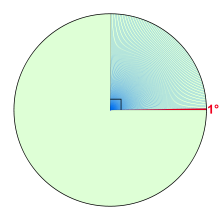Degree (angle)
| Degree | |
|---|---|
 One degree (shown in red) and 89 degrees (shown in blue) | |
| General information | |
| Unit system | Non-SI accepted unit |
| Unit of | Angle |
| Symbol | °[1][2] or deg[3] |
| Conversions | |
| 1 °[1][2] in ... | ... is equal to ... |
| turns | turn |
| radians | rad |
| gons | g |
In mathematics, a degree is a common way to measure plane angle. It is written with the symbol , where corresponds to the entire circle.[4][5][6]
It is not an SI unit. The SI uses radian to measure plane angle. However, according to the SI brochure, it is an accepted unit by SI.[7]
History[change | change source]
The actual reason of choosing the degree as a way to measure plane angle is unknown. One theory says that it is related with the fact that a year is approximately 360 days.[5] Some ancient calendars, for example the Persian calendar and the Babylonian calendar used 360 days for a year.
Another theory says that the Babylonians divided the circle using the angle of an equilateral triangle. The angle was then divided into 60 parts. This is because they used sexagesimal or base-60 numeral system.[8][9]
Related pages[change | change source]
References[change | change source]
- ↑ HP 48G Series – User's Guide (UG) (8 ed.). Hewlett-Packard. December 1994 [1993]. HP 00048-90126, (00048-90104). Retrieved 2015-09-06.
- ↑ HP 50g graphing calculator user's guide (UG) (1 ed.). Hewlett-Packard. 2006-04-01. HP F2229AA-90006. Retrieved 2015-10-10.
- ↑ HP Prime Graphing Calculator User Guide (UG) (PDF) (1 ed.). Hewlett-Packard Development Company, L.P. October 2014. HP 788996-001. Archived from the original (PDF) on 2014-09-03. Retrieved 2015-10-13.
- ↑ "Compendium of Mathematical Symbols". Math Vault. 2020-03-01. Retrieved 2020-08-31.
- ↑ 5.0 5.1 Weisstein, Eric W. "Degree". mathworld.wolfram.com. Retrieved 2020-08-31.
- ↑ "Degrees (Angles)". www.mathsisfun.com. Retrieved 2020-08-31.
- ↑ Bureau International des Poid et Mesures (2006). "The International System of Units (SI)" (8 ed.). Archived from the original on 2009-10-01.
- ↑ Jeans, James Hopwood (1947). The Growth of Physical Science. p. 7.
- ↑ Murnaghan, Francis Dominic (1946). Analytic Geometry. p. 2.






